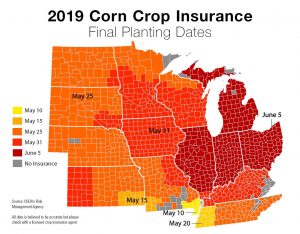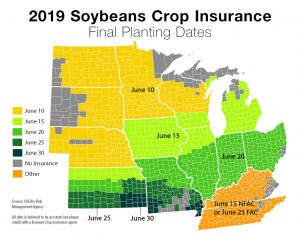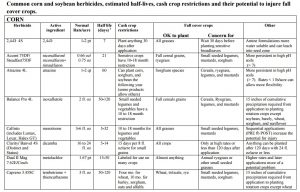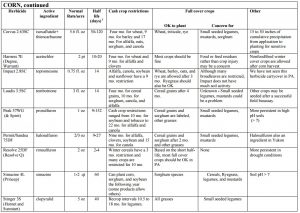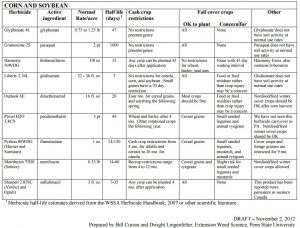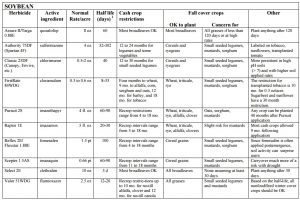Prevented Planting and Cover Crop Options for 2019
The wet spring has added an additional headache to already low commodity prices, and decisions need to be made soon on whether to take the prevented planting option with insurance. When thinking it over, consider how cover crops could play a role in protecting soil, suppressing weeds and/or growing nitrogen in prevented plant fields.
A few general things to consider when making insurance decisions:
- Communicate early and often with your crop insurance agent
- Two important terms for understanding how crop insurance payments are affected by late planting: “final planting date” and “late planting period”
- Final planting dates for corn in the Midwest: May 25 – June 5 (May 31 in Iowa).
- Final planting dates for soybeans in the Midwest: June 10 – June 20 (June 15 in Iowa).
- Late planting period is 25 days after final planting date – for corn in Iowa: June 1 – June 25
- Late planting period is 25 days after final planting date – for soybeans in Iowa: June 16 – July 10
- If you plant after the final planting date, your crop insurance coverage will be reduced by 1% per day for each day in the 25-day late planting period. After the late planting period, your crop insurance payment is reduced to 55% for corn and 60% for soybeans.
- You must notify your crop insurance agent that you were prevented from planting an insured crop within 72 hours of the end of the late planting period. In Iowa, that would be June 28 for corn and July 13 for soybeans
- Iowa Farm Bureau published a tool (download the Excel file here) to help farmers decide whether to switch from corn to soybeans or to take the full prevented planting payment
- Iowa State University Extension has several useful resources on prevented planting
Blog: Questions frequently asked about prevented planting
Blog: Delayed and Prevented Planting Provisions for Multiple Peril Crop Insurance (This blog has lots of good information on switching from corn to soybeans – planting soybeans on insured corn acres).
Presentation: Prevented Planting, Delayed Planting, and Replant Decisions
Webinar: Delayed and Prevented Planting Webinar 2019
Frequently Asked Questions (FAQ) about Prevented Planting and Cover Crops
What if I have a cover crop already planted and I know I will take prevented plant?
Use this chart from the RMA Prevented Planting Handbook to determine whether you can hay or graze and still take a prevented planting payment.
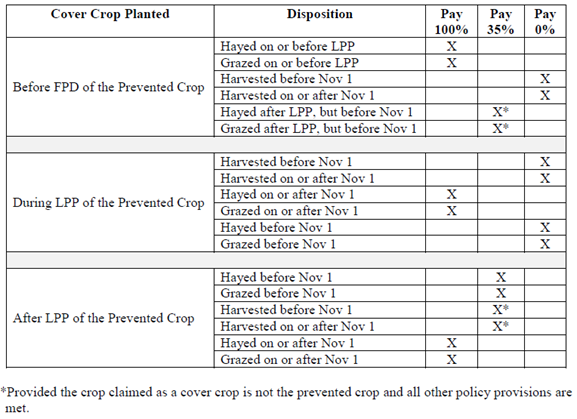
FPD: Final Planting Date; LPP: Late Planting Period *Harvesting refers to harvesting for grain or for seed.
Update for 2019 ONLY
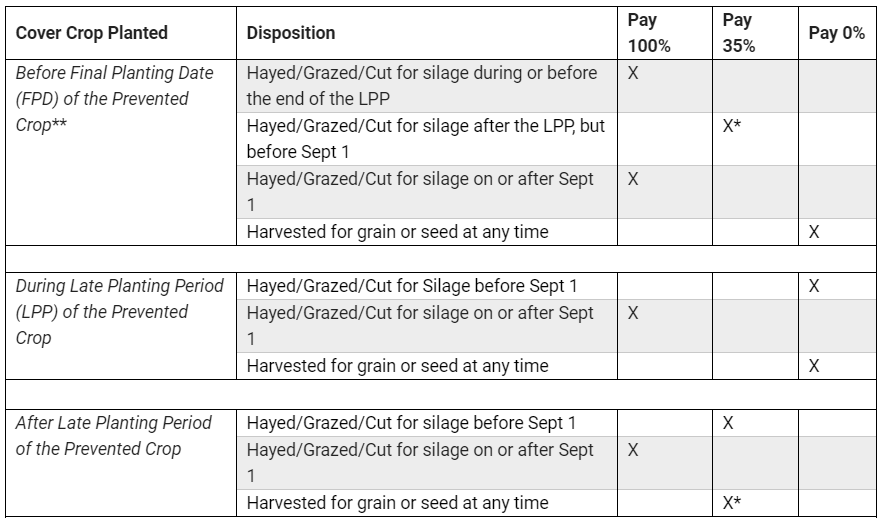
*Provided the crop claimed as a cover crop is not the prevented crop and all other policy provisions are met. ** Example: Fall-Planted Cover Crop; Spring PP Crop.
***November 1 dates are September 1 for 2019 only.
If you planted a cover crop last fall or this spring before the final planting date for an insured crop (Corn: May 31, Soybeans: June 15), you may hay or graze that before or during the 25-day late planting period, you are still eligible for a full prevented planting payment. If you hay or graze after the 25-day late planting period, but before November 1, you will be eligible for only 35% of your prevented planting payment. However, doing this may reduce the APH (actual production history) for the field, so check with your crop insurance agent before exercising this option.
You cannot take a prevented planting payment if you harvest that cover crop for seed or grain.
My fields don’t have cover crops but I’m going to take prevented planting on corn or soy, what now?
If a cover crop is planted during the 25-day late planting period of the prevented crop (in Iowa, for corn this would be June 1 – June 25, soybeans would be June 16 – July 10), then you can only take the full prevented planting payment if you do not hay/graze before November 1. If this cover crop is hayed, grazed or harvested for grain before November 1, you will be paid 0% of the prevented planting payment.
I can’t get into the field until after the late planting period to plant my cover crop, what now?
If a cover crop is planted after the 25-day late planting period of the prevented crop (in Iowa, for corn this would be June 1 – June 25, soybeans would be June 16 – July 10), then you can only take the full prevented planting payment if you do not hay/graze before November 1. If this cover crop is hayed/grazed/harvested for grain you will be paid 35% of the prevented planting payment. However, again, doing this may reduce the APH (actual production history) for the field, so check with your crop insurance agent before exercising this option.
Will the herbicides I’ve already applied limit my cover crop options?
Check out this easy-to-use guide from Penn State showing a number of corn and soybean herbicides and their potential effect on cover crops.
How much will summer cover crops cost?
Summer cover crops can be very affordable – just make sure to choose crops that won’t be inhibited by any herbicides you have already applied. We like to use Green Cover Seed’s SmartMix calculator to estimate the potential cost for a mix. You can vary the brassicas, grasses or legumes within your mix to decide what’s best. Shoot for 1 million seeds per acre and focus on good soil-to-seed contact for successful establishment. Albert Lea Seed in Minnesota has several options for cover crops on prevented planting acres – you can find more information in this info sheet
Some basics about what to do next:
1. To maximize the prevented planting payment:
- Contact your crop insurance agent within 72 hours of the end of the late planting period, plant a cover crop, but do not hay or graze the cover crop until after November 1. This maintains your eligibility to receive 100% of the prevented planting payment for that acreage.
- Contact your crop insurance agent within 72 hours of the end of the late planting period to notify them of loss due to prevented planting, then leave the acreage idle (exposed, unplanted soil vulnerable to erosion, nutrient leaching and weed growth. Weeds must be controlled and not allowed to set seed.) This also maintains your eligibility to receive 100% of the prevented planting payment for that acreage.
2. To provide some prevented planting payment with the option to provide some forage:
- Contact your crop insurance agent within 72 hours of the end of the late planting period, then plant a cover crop after this period. If you hay or graze the cover crop prior to November 1 you can receive a prevented planting payment equal to 35% of the original prevented planting guarantee for that acreage. This option will reduce the APH (actual production history) for the field, check with your crop insurance agent before exercising this option.
- If you contact your crop insurance agent more than 72 hours after the end of the late planting period, leave the acreage idle (exposed, unplanted soil vulnerable to erosion, nutrient leaching and weed growth) you could receive a reduced prevented planting payment for that acreage.
3. To maximize the forage opportunity:
- Plant a cover crop before the final planting date or during the late planting period, hay or graze the cover crop prior to November 1 and receive no prevented planting payment.
Prevented Planting Options and Economics
For farmers and ranchers unfamiliar with cover crops, the following table provides some guidelines when considering options under prevented planting conditions. Consult with your agronomist before making any changes to your cropping plan. Also, be sure to consult with your county Natural Resources Conservation Service (NRCS) office about how changing your cropping plan would affect any contracts you might have through EQIP, CSP, or other working lands programs.
Table 1. 2019 Prevented Plant Corn Options and Economics
| Prevented planting (PP) options | PP payment/acre | Nitrogen storage* and weed Control | Soil erosion prevention value^ | Fallow syndrome yield reductionᴪ | Average cover crop seed cost/acre | Potential forage value/acre | Return/acre |
| Option 1: Full prevented planting corn; leave acres idle.
No Cover Crop |
$362 (100% of original PP guarantee at 80% coverage) Calculated from IFB Tool | N lost: $20-$40, $12 weed control
AVG -$42 |
Soil loss: $7-$21
AVG -$14 |
Future yield loss: $30-$90
AVG -$60 |
$0 | $0 | $245.80 |
| Option 2: Full prevented planting corn; plant cover crop during or after late planting period; do not hay/graze the cover crop before Nov. 1.
Cover Crop |
$362 (100% of original PP guarantee at 80% coverage) Calculated from IFB Tool | N stored: $20-$40
AVG $30
|
Soil saved: $7-$21
AVG $14 |
Future yield loss:
AVG $0 |
$40 | $0-$200 (if harvestable after Nov 1) | $405.80-$605.80 |
| Option 3: Full prevented planting corn; plant cover crop (not during the late planting period); do hay or graze before Nov. 1.
Cover Crop |
$127 (35% of original PP guarantee at 80% coverage) Calculated from IFB Tool | N stored: $20-$40
AVG $30
|
Soil saved: $7-$21
AVG $14 |
Future yield loss:
AVG $0 |
$40 | $400-$1000 | $570.63-1170.63 |
| Average of the range for Nitrogen Storage, Soil Erosion Prevention and Fallow Syndrome Yield Reduction are reported and used in the final calculations. Ranges are reported using the PP payment/acre and Potential forage value/acre. Estimates are taken from:
*Kaspar, T.C., and J.W. Singer. 2011. The use of cover crops to manage soil. p. 321-337. In J.L. Hatfield and T.J. Sauer (eds.) Soil management: Building a stable base for agriculture. American Society of Agronomy and Soil Science Society of America, Madison, WI. Clark, A., (ed.) 2007. Managing cover crops profitably. Sustainable Agriculture Network, Beltsville, MD. ^Duffy, M. (2012). Value of Soil Erosion to the Land Owner (No. 34959). ᴪEllis, J.R. 1998. Post flood syndrome and vesicular-arbuscular mycorrhizal fungi. Journal of Production Agriculture. Volume 11, no. 2: 200-204 Troeh, Z.I., and T.E. Loynachan. 2003. Endomycorrhizal fungal survival in continuous corn, soybean, and fallow. Agron. J. 95:224-230. Post Flood and Fallow Syndrome Examined by Daniel Wiersma and Paul Carter Crop Insights. Pioneer International. |
|||||||
Keep me posted throughout the year with how your cover crop plan went on your prevented planting acres! sarah@practicalfarmers.org or call me at the office – 515-232-5661!

